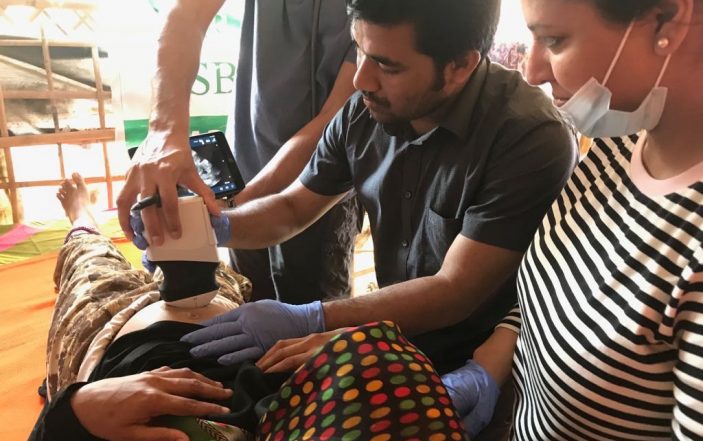Breaking down device’s strengths and limitations on aid mission
While working at a relief camp in Bangladesh in March, Debjeet Sakar, MD and second year medical student AJ Folsom used the device for obstetrics and set up a small ultrasound area to provide pregnant women basic ultrasound images of their babies.
As the role of sonography in medicine continues to expand, some manufacturers have begun producing portable ultrasound devices at prices facilitating individual ownership. These handheld, wireless devices can improve healthcare in austere, pre-hospital settings, such as disaster relief, humanitarian aid or military field use. We drew on our military training and deployment experiences to assess whether the device would be practical in a field environment.
While FAST exams seem like the most obvious application, we also used it for obstetrics, ophthalmology, pediatrics and trauma. A large portion of using the device was dedicated to teaching local resident physicians about basics of ultrasound imaging.
Device tested: Clarius C3 Convex, 2-6 MHz transducer
Specifications:
-Image maximum depth: 32 cm
-Dimensions: 6.6” (H) x 3.9” (W) x 1.6” (D)
-Weight with battery: 1.2 lbs.
-Transmits image to smart device via self-generated Wi-Fi (no connectivity required)
-Operating Range: 32-104°F, 15-90% relative humidity
-Recommended maximum exam time: 20 minutes
-Approximate continuous scan time per battery: 60 minutes
Pros:
-Wireless—no connectors or ports to break, easy to pack
-Good image quality
-Lightweight
-Durable—hard outer shell can withstand being dropped from 1 meter
-Waterproof—can be immersed (without battery) in 1 meter of water for 30 minutes
-Removable battery design with appropriate scan time for field setting
-Intuitive Clarius App (can be used with either Android or iOS) with easy on-screen image controls—excellent for teaching
Cons:
-Overheated rapidly—even with portable fan clip attachment the device was hot to the touch
-Large transducer profile—compression of surrounding structures complicated pediatric cases and cardiac windows; hard to use in confined areas or for users with smaller hands. We tested the C3 convex to have the most all-in-one we could get. There is also a dedicated linear one, L3 and a microconvex C7. (Note: we did not test the company’s clip-on covers, which minimize the scanner surface area)
-Switching between smart devices required a 3-4 minute restart, causing scan delays in a time-constrained environment. For most locations, the tablet provides the best resolution and touch screen activity.
-Blue-to-green light system (going from “ready to scan” to “scanning”) was confusing and could create an unwanted light signature during military operations
Conclusion
The Clarius C3 Convex functioned well for intermittent use during a humanitarian aid mission in an austere environment. We found some limitations, mainly overheating and getting specific imaging windows with a bulkier probe. The device’s wireless design has advantages in durability and for lightweight packing, but does require users to account for the wireless connection process.
The device was well received by the resident physicians and the Clarius App made it easy to use as a teaching tool. Of note, for a setting needing multiple consecutive days of field use, additional batteries or access to a generator would be necessary.
Portable ultrasound devices enable providers to push imaging as close as possible to the initial point of care. Potential future usage areas include: moving ground and air evacuation vehicles, telemedicine consults and use in mass casualty incidents to aid in triage. In remote settings, devices like the Clarius have potential to significantly improve diagnosis, management and outcomes for patients.









